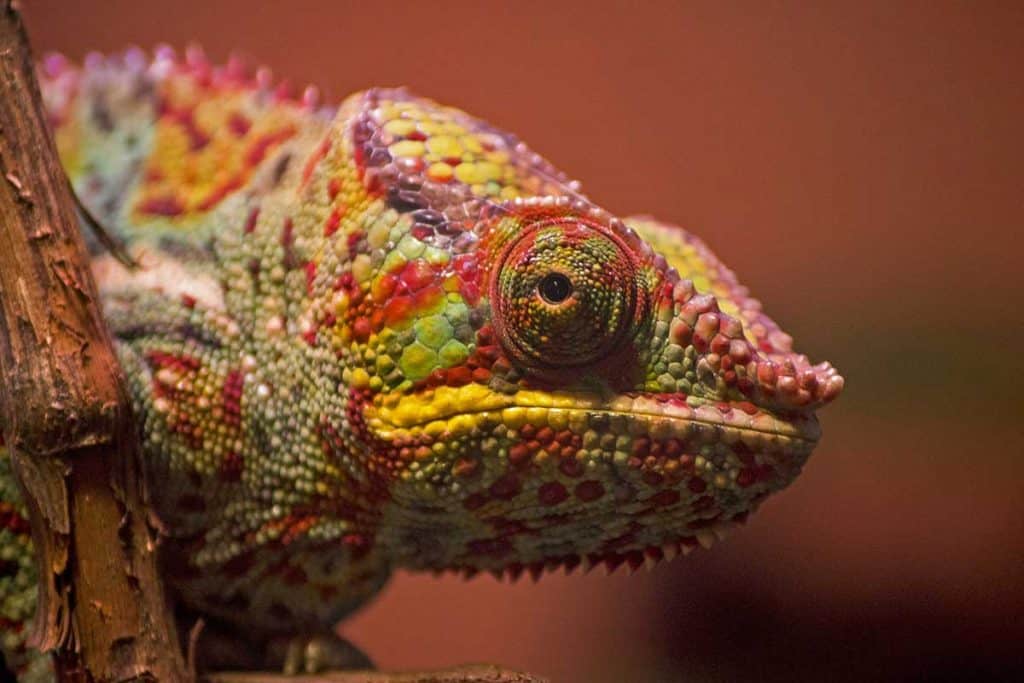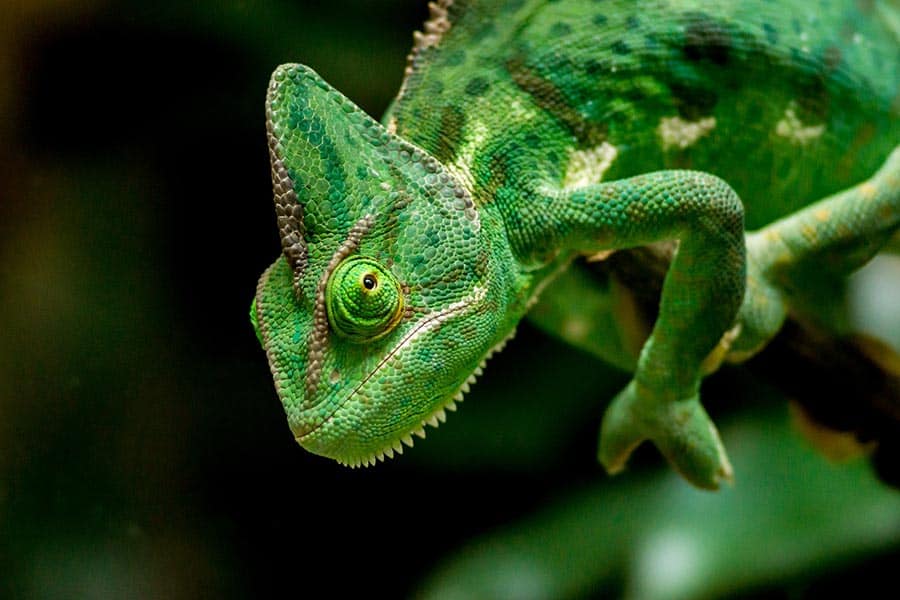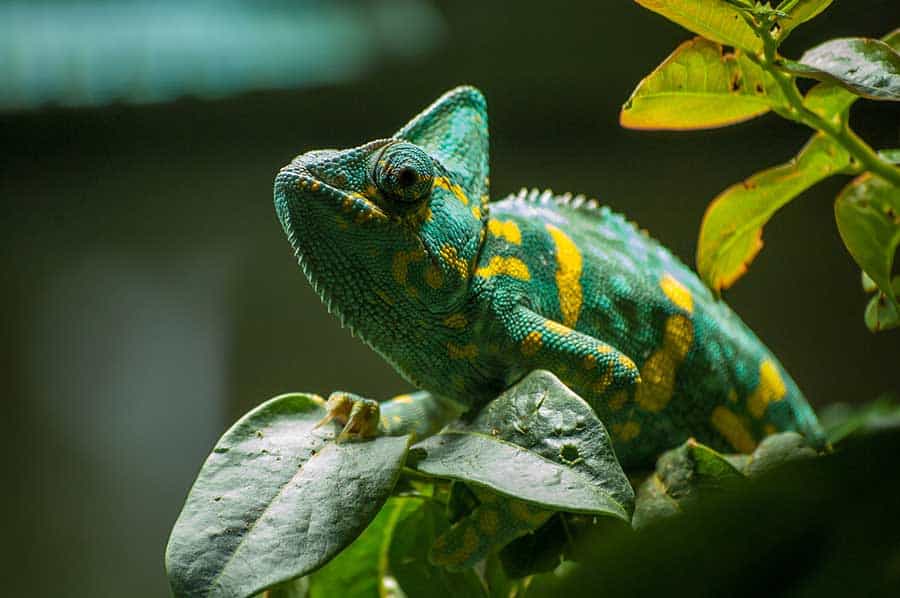Chameleons are difficult lizards to keep because a lot can go wrong, even for an experienced reptile owner. One of the leading causes of death in pet chameleons is dehydration.
Owners who do not know how chameleons drink water are the leading cause of dehydration in their pets. Chameleons will not drink standing water from a dish like some other lizards. They will only drink droplets of water off of surfaces such as leaves, meaning proper humidity levels in their enclosure is critical to their survival.
Simply leaving a bowl of water in the enclosure is not enough. You need to install a drip system (bought or homemade) and mist the enclosure daily. Your chameleon will seek out the water droplets that form on the leaves, branches, and fixtures in their habitat.
Luckily, a dehydrated chameleon will display several specific physical symptoms that will tell you they are dehydrated and need urgent care. These symptoms include sagging skin, sunken eyes, yellow to orange urate, distinct lethargy, and a loss of appetite.
Fortunately, if your chameleon is not too far gone, there are ways to rehydrate it. However, there is a very small time frame before there is permanent damage done. This is why you need to keep an eye on your chameleon and give it and its enclosure a ‘once over’ every day in case anything needs to be adjusted.
Causes of Dehydration in Chameleons
Lack of Water Droplets
Chameleons drink from water droplets they find in their environment. They will often find water droplets on a leaf or hanging off an object and touch the ball of their tongue to them so the tiny droplets fall into their mouths.
This means there needs to be plenty of water droplets for your chameleon to drink from at all times. The best way to do this is to set up a dripping system. You can also set up a homemade version of the dripping system. Just make sure the water is not a constant stream, as this will offset the humidity in the enclosure, and your chameleon won’t want to drink the flowing water anyway.
Humidity Is Too Low
A chameleon’s enclosure needs to be misted once to twice a day to maintain the correct level of humidity.
The enclosure should stay within the 65% to 80% range. Any higher than this and your chameleon will develop respiratory problems. Any lower than this range, though, and your chameleon risks becoming dehydrated.
This level of humidity needs to be carefully monitored by a quality hygrometer. You can maintain the humidity by misting daily or setting up a misting or fogging system.
Temperature Is Too High
If a chameleon’s enclosure is too hot, then they will lose water rapidly. A high temperature also means that any water that is misted into the enclosure will evaporate before your chameleon gets a chance to drink from the drops.
The daytime temperature of a chameleon’s enclosure should sit at around 80°F. However, some chameleons prefer it warmer, so make sure you verify the species of chameleon you have and adjust their temperature settings accordingly.
Illness
Illness in chameleons can lead to a loss of appetite, which will, in turn, affect their hydration levels. Illnesses such as parasite infestation or gut problems can lead to diarrhea. If your chameleon has diarrhea, they will lose a huge amount of liquid and be unable to replace it fast enough.
If you suspect your chameleon is ill, take it to the vet as soon as you can to get a proper diagnosis and treatment plan. Prolonged or chronic diarrhea in reptiles, particularly chameleons, can be fatal.
5 Warning Signs of a Dehydrated Chameleon
1. Sagging Skin or Excessive Skin Folding
Dehydration will lead to large folds in the skin due to sagging. When a chameleon is dehydrated, their skin loses much of the hydration and elasticity required for it to be taut. It is similar to when a human is dehydrated: if you pinch their skin, it will remain pinched instead of bouncing back to normal.
If you are worried about your chameleon’s hydration levels, then gently pull/pinch the skin on the side of the body. If it springs back, then your chameleon is hydrated. If it moves slowly back to normal or does not move at all, then they are dehydrated.
2. Sunken Eyes
Sunken eyes are another telltale sign a chameleon is dehydrated. Their eyes need plenty of hydration in order to move around and allow them to properly see. If your chameleon is dehydrated, then the eyes will retreat and become sunken in because the skin is not as taut as it should be. This is also a way for them to protect themselves from drying out.
However, if sunken eyes is a stand-alone symptom, then it probably indicates stress or fear more than dehydration.
3. Yellow to Orange Urate
Like many other lizards, such as bearded dragons, a chameleon’s poop will tell you a lot about its state of health.
The urate is the white part of their poop. If your chameleon is properly hydrated, then the urate will be white or slightly off-white. However, if your chameleon is dehydrated, then the kidneys cannot produce any white urate.
Yellow urate is a sign of mild dehydration or sickness. Orange urate is a sign of serious dehydration, and you should get your chameleon to the vet immediately if they display this symptom.
4. Lethargy
Lethargy means a lack of movement due to fatigue, tiredness, or pain. If your chameleon is dehydrated, it will not have the energy to move around as much as it usually does. It might also stick to the lower branches or even the floor of the enclosure rather than climbing and exploring as they usually do.
The main problem with a lethargic chameleon is they will generally be too tired to seek out water droplets. If your chameleon becomes lethargic, it is usually a sign of severe dehydration or another health problem.
5. Lack of Appetite
A dehydrated chameleon will not have an appetite. This is a problem because food is a key way to reintroduce liquid back into your chameleon’s diet. If your chameleon gets to this stage, you must get them to a vet.
A loss of appetite could also be a sign of another health problem, so keeping a careful eye on your chameleon’s eating habits is important. This way, you will notice any irregularities and be able to address them accordingly. Some reptile owners keep a food journal to track what and how much their pets eat.
How to Rehydrate Your Chameleon
If your chameleon is severely dehydrated, then they need to see a vet that specializes in reptiles immediately. Severe dehydration results in orange urate and a combination of the previously mentioned symptoms.
However, if your chameleon is mildly dehydrated, then there are several things you can do at home to rehydrate them. Mild dehydration results in yellowish urate and usually one or more of the previously mentioned symptoms.
Here are some of the things you can do at home to rehydrate your chameleon!
Misting
Misting should be your first step to rehydrate your chameleon. For mildly dehydrated chameleons, this method should work most of the time. However, if your pet is still dehydrated and all of your other husbandry settings are correct, then you should try a few other methods and then seek veterinary help.
You will need to increase the frequency and the duration that you mist your chameleon’s enclosure if they are dehydrated. You can also dedicate a specific leaf or perch that you mist heavily so that there are a lot of droplets on it, then put your chameleon on that perch and carefully monitor and track how much they drink.
Real Plants
A really great way to improve and maintain humidity in your chameleon’s enclosure is to include live plants! Good options are golden pothos, grape ivy, Boston fern, and ti plants.
Real plants hold water droplets longer than synthetic ones do, so this gives your chameleon more chances to drink up! Real plants come with more care requirements, but they also significantly improve your chameleon’s overall health in the long term.
Shower Time!
Giving your chameleon a shower should not be done too often. Additionally, you should never give a shower to a chameleon under five months old. Babies and young juveniles are prone to drowning in a chameleon shower because the water droplets are too big for them to drink.
Put your chameleon onto a perch that you can secure in your shower. Place the perch in the shower and make sure there is no chance that it can fall, as this will kill your pet.
Direct the shower spray away from your chameleon and onto a wall so that the water droplets will bounce back onto it. Make sure the water is not hot and not cold; it should feel slightly warm, like the same temperature as your skin. You do not want to raise or lower your chameleon’s body temperature.
Generally, you’ll want to put your chameleon in the shower for about 20 to 40 minutes at a time. Do not leave them unattended or with a child, and never shower with them! The fragrances and chemicals in products like shampoo and soap will harm your chameleon.
Watch them carefully for signs of distress and remove them if they become agitated. These signs can be rapidly changing skin colors, darkening of the skin, or puffing of the chest.
Fruit
Giving your chameleon fruit is a great way to up their hydration levels. Fruit is tasty and sweet, so it encourages a chameleon who is not too interested in food or drinking to eat.
Small amounts of fruits with high water contents such as watermelon, sweet melon, strawberries, and grapes can be offered to your chameleon. Always remember to remove all seeds, pips, stones, and stems before feeding.
Never offer your chameleon citrus fruits, avocado, or tomatoes. These fruits are very acidic and will cause your chameleon harm.
Always make sure the piece of fruit is the right size for your chameleon to avoid choking. As a general rule, the piece of fruit should not be larger than the space between your chameleon’s eyes.
After you have given your chameleon some fruit, offer them a crunchy insect like a cricket or dubia roach so that there is no fruit left in your chameleon’s mouth. The insects will sort of work to clean your chameleon’s teeth. If fruit stays stuck between your chameleon’s teeth, it can ferment and rot, which causes tooth decay and gum disease.
Emergency Dropper
In cases where it does not look like your chameleon wants to look for water, you can reach for the dropper.
Take a small dropper or pipette, fill it up with water, and offer your chameleon droplets from it. You must do this slowly and carefully, or you could cause your chameleon to choke or even drown!
Always use a bendable plastic dropper and never a glass one. This is a precaution in case your chameleon bites the dropper. This way, they won’t have to deal with a mouth full of broken glass!
It is also important to never use a syringe to do this because directly squirting the water into your chameleon’s mouth will cause it to choke or accidentally drown.
Electrolytes
If you are worried the water is not enough for your chameleon to rehydrate them, then you can include some electrolytes to further boost their hydration.
Using the same method with the dropper or pipette, prepare a half water and half electrolyte-rich liquid solution for your chameleon.
Safe liquids that are rich in electrolytes include coconut water or watermelon juice. Make sure these do not have added sugar in them. You can also use a sugar-free sports drink. Opt for one that doesn’t have too much flavoring or extra colorants.
FAQs Hydrating Chameleons
Can I train my chameleon to drink from a water bowl if I start from when it’s a baby?
Unfortunately, chameleons do not even recognize standing water as water. They will only lap up water droplets. Therefore, it would not be possible to train them to drink from a
How long does it take to rehydrate a dehydrated chameleon?
Depending on the severity of your chameleon’s dehydration, it may take anywhere from a few days to a week or more to get their hydration levels back up to a healthy level. If your chameleon doesn’t show signs of improvement after several days, get them to a qualified reptile veterinarian immediately for further instruction.
The Last Drop…
Chameleons are a very unforgiving lizard when it comes to owners making mistakes with their husbandry requirements. This means you’ll need to stay on top of their humidity and temperature levels at all times.
Keeping a careful eye on your chameleon’s behavior should be a top priority, but sometimes things out of your control happen and they get sick or get a bit dehydrated. Now you have the knowledge on how to identify and rehydrate your chameleon!





